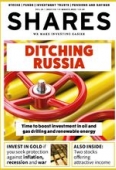Archived article
Please note that tax, investment, pension and ISA rules can change and the information and any views contained in this article may now be inaccurate.
Fancy 9% dividend yield? M&G is the answer

British insurer and asset management firm M&G (MNG) surprised the market with better-than-expected full year results on 8 March. This has made investors look more closely at the investment opportunity and we think you should do the same. M&G’s shares are cheap, trading on 8.3 times 2023 forecast earnings, and the dividend is very attractive with a 9.2% prospective yield based on next year’s expected payment. Berenberg forecasts M&G will pay 19.82p per share in dividends for 2022, 20.65p in 2023 and 21.68p in 2024.
M&G’s shares are cheap, trading on 8.3 times 2023 forecast earnings, and the dividend is very attractive with a 9.2% prospective yield based on next year’s expected payment. Berenberg forecasts M&G will pay 19.82p per share in dividends for 2022, 20.65p in 2023 and 21.68p in 2024.
The UK life market benefits from strong macro trends that continue to drive change and growth in the industry.
Over the past decade, and since the global financial crisis, insurers have focused on improving capital buffers, cutting costs and de-risking their balance sheets to improve their solvency and margins.
In the UK, the combination of an ageing population and the ongoing shift of responsibility for retirement income from corporates and the state to the individual should continue to fuel growth in the long-term savings market for years to come. M&G is ideally positioned to benefit from these trends.
The company was spun out of Prudential (PRU) in 2019 and since then it has completed key demerger targets ahead of schedule. It achieved £2.8 billion capital generation over two years, versus an original target of £2.2 billion by the end of 2022. Annual cost savings of £145 million were achieved a year earlier than planned.
This strong performance has enabled the group to announce a £500 million share buyback programme. This amount, together with dividends, will mean the group has returned £1.8 billion of capital to shareholders, equivalent to 32% of its market value at the time of the demerger.
There are some potential areas of risk. For example, the group could face prolonged outflows in retail asset management, with lower growth in institutional asset management.
However, for now, we see plenty of reasons to stay positive. For example, the group should continue to build up excess capital, assuming cash generation of £800 million per year. Given that dividends account for 66% of this cash generation, it is apparent that excess capital will continue to accumulate in the business. Research by Berenberg suggests a figure of £1 billion.
Asset management flows have turned positive for the first time since the demerger from Prudential. Moreover, there are encouraging indications regarding the prospect of a continued turnaround in the retail division.
The launch of M&G’s saving product PruFund in Italy offers a significant competitive advantage and could prove to be a welcome addition to earnings in the medium term.
Important information:
These articles are provided by Shares magazine which is published by AJ Bell Media, a part of AJ Bell. Shares is not written by AJ Bell.
Shares is provided for your general information and use and is not a personal recommendation to invest. It is not intended to be relied upon by you in making or not making any investment decisions. The investments referred to in these articles will not be suitable for all investors. If in doubt please seek appropriate independent financial advice.
Investors acting on the information in these articles do so at their own risk and AJ Bell Media and its staff do not accept liability for losses suffered by investors as a result of their investment decisions.
Issue contents
Editor's View
Feature
Great Ideas
- Tharisa shares hit new record high as metal prices rally
- Why Hill & Smith’s share price has fallen too far
- Fancy 9% dividend yield? M&G is the answer
- Hargreaves Services delights investors by raising its full year outlook again
- Buy this Canadian fund for income and exposure to attractive sectors
- Don’t panic about drop in Heptagon European fund
News
- Quality growth strategy delivered strong returns in 2021 for Smithson
- Sanctions create potential earnings boost for non-Russian potash producers
- Mike Ashley increases Frasers’ stake in German fashion retailer Hugo Boss
- Why global shares could receive a major boost from large pension fund rebalancing
- Investors in China should brace for even greater volatility as risks multiply

 magazine
magazine








